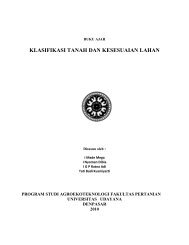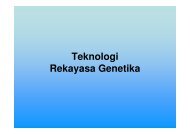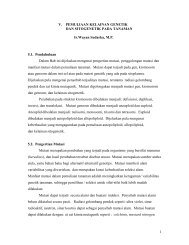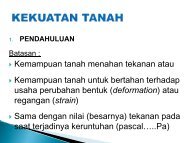Robust CTAB-activated charcoal protocol for plant DNA extraction
Robust CTAB-activated charcoal protocol for plant DNA extraction
Robust CTAB-activated charcoal protocol for plant DNA extraction
You also want an ePaper? Increase the reach of your titles
YUMPU automatically turns print PDFs into web optimized ePapers that Google loves.
Acta agriculturae Slovenica, 87 - 2, september 2006 str. 427 - 433<br />
Agrovoc descriptors: <strong>plant</strong>s, <strong>DNA</strong>, <strong>activated</strong> carbon, <strong>extraction</strong>, polyphenols, PCR,<br />
polysaccharides<br />
Agris category code: F30<br />
<strong>Robust</strong> <strong>CTAB</strong>-<strong>activated</strong> <strong>charcoal</strong> <strong>protocol</strong> <strong>for</strong><br />
<strong>plant</strong> <strong>DNA</strong> <strong>extraction</strong><br />
COBISS Code 1.01<br />
Mitja KRIŽMAN 1 , Jernej JAKŠE 2 , Dea BARIČEVIČ 3 , Branka JAVORNIK 4 ,<br />
Mirko PROŠEK 5<br />
Received July 21, 2006; accepted August 24, 2006<br />
Prispelo 21. julija 2006; sprejeto 24. avgusta 2006<br />
ABSTRACT<br />
<strong>DNA</strong> extracted from <strong>plant</strong>s rich in polyphenols and/or polysaccharides is often problematic<br />
when subjected to polymerase chain reaction, especially when mature tissues are used <strong>for</strong><br />
<strong>DNA</strong> <strong>extraction</strong>. In order to overcome the problems associated with poor-quality <strong>DNA</strong><br />
extracted from such <strong>plant</strong> samples, a <strong>protocol</strong> has been developed, availing on a high salt<br />
concentration and on the combination of polyvinylpyrrolidone and <strong>activated</strong> <strong>charcoal</strong> in the<br />
<strong>extraction</strong> buffer, in order to prevent the solubilization of polysaccharides and polyphenols in<br />
the <strong>DNA</strong> extract. Mild temperature conditions during <strong>extraction</strong> and precipitation were also<br />
recognized as important parameters. Besides <strong>DNA</strong> purity, mild precipitation conditions were<br />
found to be beneficial in obtaining less low-molecular mass nucleic acids in the final <strong>DNA</strong><br />
extract. The homogenization step and the amount of sample extracted were also found to be<br />
crucial in keeping the <strong>extraction</strong> procedure robust.<br />
Key words: <strong>activated</strong> <strong>charcoal</strong>, <strong>DNA</strong> <strong>extraction</strong>, PCR amplification, polyvinylpyrrolidone<br />
IZVLEČEK<br />
ROBUSTEN PROTOKOL ZA EKSTRAKCIJO RASTLINSKE DNK S POMOČJO <strong>CTAB</strong> IN<br />
AKTIVNEGA OGLJA<br />
DNK, ekstrahirana iz rastlin z visoko vsebnostjo polifenolov in/ali polisaharidov, je pogosto<br />
problematična z vidika uporabe le-te v polimerazno verižni reakciji, še posebej če je bila DNK<br />
ekstrahirana iz zrelih tkiv. V izogib težavam, povezanih s slabo kakovostjo ekstrahirane DNK,<br />
smo razvili ekstrakcijski protokol, ki temelji na ekstrakcijskem pufru z visoko vsebnostjo soli<br />
ter kombinirane uporabe polivinilpirolidona in aktivnega oglja. Taka sestava ekstrakcijskega<br />
pufra preprečuje sočasno raztapljanje polisaharidov in polifenolov z DNK. Kot odločilen<br />
dejavnik pri postopku izolacije DNK smo identificirali tudi blage temperaturne razmere v<br />
1 Research Assistant, B. Sc., SI-1000 Ljubljana, Hajdrihova 19; e-mail: mitja.krizman@ki.si<br />
2<br />
Assistant Prof., Ph. D., Biotechnical Faculty, University of Ljubljana, SI-1000 Ljubljana<br />
Jamnikarjeva 101<br />
3<br />
Associate Prof., Ph. D., SI-1000 Ljubljana Jamnikarjeva 101<br />
4 Prof., Ph. D., SI-1000 Ljubljana Jamnikarjeva 101<br />
5 Head of Laboratory, Ph. D., SI-1000 Ljubljana, Hajdrihova 19
428 Acta agriculturae Slovenica, 87 - 2, september 2006<br />
stopnjah ekstrakcije in obarjanja. Poleg ugodnega vpliva na čistost, so blage razmere<br />
obarjanja pomebne tudi zaradi vpliva na manjšo vsebnost nukleinskih kislin z nižjimi<br />
molekulskimi masami v končnem DNK ekstraktu. Ugotovili smo tudi, da na robustnost<br />
postopka pomembno vplivata tako količina ekstrahiranega vzorca kot njegova<br />
homogenizacija.<br />
Ključne besede: aktivno oglje, ekstrakcija DNK, amplifikacija s polimerazno verižno reakcijo,<br />
polivinilpirolidon<br />
1 INTRODUCTION<br />
<strong>DNA</strong> <strong>extraction</strong> from <strong>plant</strong>s is preferentially per<strong>for</strong>med from young tissues due to the<br />
lower content of polysaccharides, polyphenols and other secondary metabolites which<br />
coprecipitate with <strong>DNA</strong> in the <strong>extraction</strong> procedure, inhibit <strong>DNA</strong> digestion and PCR<br />
(Zhang and McStewart, 2000), presumably by irreversible interactions with <strong>DNA</strong><br />
(Dabo et al., 1993). It has been shown that <strong>DNA</strong> extracts from tissues past the<br />
budding stage are problematic and also unstable under long-term storage (Lodhi et al.,<br />
1994). However, in cases when only older tissues are available, a proper procedure<br />
<strong>for</strong> selective <strong>extraction</strong> of <strong>DNA</strong> is needed. Hexadecyltrimethylammonium bromide<br />
(<strong>CTAB</strong>) is a frequently used surfactant in <strong>DNA</strong> <strong>extraction</strong> and several modifications<br />
of the <strong>CTAB</strong> <strong>protocol</strong> originally published by Doyle and Doyle (1987) have been<br />
made. Modifications were focused on the use of polyvinylpyrrolidone (PVP) or<br />
<strong>activated</strong> <strong>charcoal</strong> or combination of both (Maliyakal, 1992; Bi et al., 1996; Porebski<br />
and Bailey, 1997; Peterson and Boehm, 1997; Kim et al., 1997; Martellossi et al.,<br />
2005) in order to remove polyphenolics from further <strong>extraction</strong> steps. For<br />
polysaccharide removal, precipitation by high salt concentrations proved to be<br />
effective (Fang et al., 1992), or eventually, pectinase could also be used (Rogstad et<br />
al., 2001).<br />
The presented <strong>protocol</strong> was primarily developed <strong>for</strong> <strong>DNA</strong> <strong>extraction</strong> from maturing<br />
leaf tissue of fennel (Foeniculum vulgare), known <strong>for</strong> its high essential oil and<br />
polyphenolic content (Oktay et al., 2003; Parejo et al., 2004; Krizman et al., 2006).<br />
Maturing fennel leaf tissue, with a considerable amount of secondary metabolites, was<br />
used as starting material <strong>for</strong> genetic studies since the same samples were used <strong>for</strong><br />
chemotypic studies as well. The <strong>protocol</strong> proved to be useful also <strong>for</strong> <strong>DNA</strong> <strong>extraction</strong><br />
from samples of other recalcitrant <strong>plant</strong> species such as oregano (Origanum vulgare)<br />
leaves, hemp (Cannabis sativa) seeds, hop (Humulus lupulus) dried cones and coffee<br />
(Coffea arabica) green beans. The <strong>extraction</strong> procedure is based on <strong>activated</strong> <strong>charcoal</strong><br />
and PVP <strong>for</strong> binding of polyphenolics during <strong>extraction</strong> and on mild <strong>extraction</strong> and<br />
precipitation conditions, promoting high-molecular weight <strong>DNA</strong> isolation without<br />
interfering contaminants. During <strong>protocol</strong> development, we have also focused on<br />
keeping the <strong>protocol</strong> as simple as possible, minimizing the number of steps involved.
KRIŽMAN, M. et al: <strong>Robust</strong> <strong>CTAB</strong>-<strong>activated</strong> <strong>charcoal</strong> <strong>protocol</strong> <strong>for</strong> <strong>plant</strong> <strong>DNA</strong>… 429<br />
2 MATERIALS AND METHODS<br />
2.1 Plant material<br />
Fennel leaves and fruits were collected during the flowering period (July 2005) and the<br />
ripening period (October 2005), respectively, in Slovene Istria region. Oregano leaves were<br />
obtained from the experimental fields (yield 2005) of Biotechnical Faculty, University of<br />
Ljubljana (Slovenia). Dried hop cones were obtained from the experimental fields (yield 2005)<br />
of Institute of Hop Research and Brewing Žalec (Slovenia). Hemp seeds were from a<br />
commercial lot of Hungarian cultivar Unico. Samples of coffee beans were kindly donated by<br />
Dr. Furio Suggi Liverani and Dr. Lorenzo Del Terra from Illycaffè S.p.A., Triest, Italy.<br />
2.2 Reagents and chemicals<br />
• Extraction buffer: 100 mM Tris-HCl (pH 8), 2.0 M NaCl, 20 mM EDTA (pH 8), 2 % (w/v)<br />
<strong>CTAB</strong>, 1 % (w/v) PVP (PVP K10, MW 10.000). Be<strong>for</strong>e use, suspend 0.5 % (w/v) of<br />
<strong>activated</strong> <strong>charcoal</strong> in the <strong>extraction</strong> buffer and use it within 3 days. Agitate the suspension<br />
be<strong>for</strong>e pipetting.<br />
• Chloro<strong>for</strong>m-isoamylalcohol: 4% (v/v) isoamylalcohol in chloro<strong>for</strong>m<br />
• Wash solution: 15 mM ammonium acetate in 75 % (v/v) ethanol<br />
• TE buffer: 10 mM Tris-HCl (pH 8), 1 mM EDTA (pH 8)<br />
• Isopropanol<br />
2.3 <strong>DNA</strong> <strong>extraction</strong> <strong>protocol</strong><br />
• Finely homogenize 5 mg to 50 mg of <strong>plant</strong> tissue (depending on the species, the tissue<br />
and its maturity) in a mortar with 1.5 mL of <strong>extraction</strong> buffer. Transfer the mixture into a<br />
microcentrifuge tube. When expecting low <strong>DNA</strong> yields, increase the sample amount, but<br />
proportionally increase the volume of <strong>extraction</strong> buffer as well. Incubate the mixture at<br />
55 °C <strong>for</strong> 30 min with frequent agitation, avoiding the suspension to settle. Cool down to<br />
room temperature.<br />
Note: Avoid tissue freeze-grinding, milling or another type of homogenization be<strong>for</strong>e<br />
adding the <strong>extraction</strong> buffer, since it increases the chances of <strong>DNA</strong> contamination, unless<br />
the tissue is physically though and with a low amount of water (e.g. seeds, beans etc.).<br />
When dealing with though tissues (e.g. coffee beans), it is advisable to presoak the<br />
ground tissue (only the finest fraction) in the <strong>extraction</strong> buffer <strong>for</strong> 2 hours at room<br />
temperature be<strong>for</strong>e <strong>extraction</strong> and avoiding further homogenization with the <strong>extraction</strong><br />
buffer in a mortar.<br />
• Centrifuge at 16000 g <strong>for</strong> 10 min at room temperature. Transfer the supernatant to a new<br />
tube.<br />
• Add 1 volume of chloro<strong>for</strong>m-isoamylalcohol to the supernatant and vortex thoroughly.<br />
Centrifuge at 16000 g <strong>for</strong> 10 min at room temperature. Transfer the aqueous (upper)<br />
phase to a new tube. Repeat the chloro<strong>for</strong>m-isoamylalcohol <strong>extraction</strong> once or more, if<br />
cloudiness in the solution persists.<br />
• Transfer the supernatant to a new tube, add 0.45 volume of isopropanol and mix by<br />
inversion. Incubate at 25 °C <strong>for</strong> 1 hour. Centrifuge at 700 g <strong>for</strong> 10 min at room<br />
temperature.<br />
• Discard the supernatant. Wash the pellet by adding 1 mL of wash buffer and vortex.<br />
Centrifuge at 900 g <strong>for</strong> 10 min at room temperature.<br />
• Discard the supernatant and air dry the pellet at room temperature, but do not overdry.<br />
• Dissolve the pellet in 25 µL of TE buffer. If there are some impurities left, centrifuge at<br />
16000 g <strong>for</strong> 10 min at room temperature and transfer the supernatant to a new tube.<br />
Store the <strong>DNA</strong> solution at 4 °C <strong>for</strong> short-term or at –20 °C <strong>for</strong> long-term storage. If<br />
needed, treat the <strong>DNA</strong> solution with RNase be<strong>for</strong>e use.<br />
3 RESULTS AND DISCUSSION<br />
The extracted <strong>DNA</strong> was quantified by a fluorometric assay using a Hoefer DyNA<br />
Quant 200 fluorometer and a <strong>DNA</strong>-specific dye, Hoechst H33258 (Hoefer, San
430 Acta agriculturae Slovenica, 87 - 2, september 2006<br />
Francisco, CA, USA), according to manufacturer’s instructions. For each type of <strong>plant</strong><br />
sample, six replicates were subjected to fluorometric measurements. The average<br />
results are shown in Table 1. Suitability of the isolated <strong>DNA</strong> was assessed by PCR<br />
amplification of the internal transcribed spacer (ITS) region of ribosomal <strong>DNA</strong><br />
(White et al., 1990) by using a TGradient thermal cycler (Biometra, Göttingen,<br />
Germany) with ITS1 (5'-TCCGTAGGTGAACCTGCGG-3') and ITS4 (5'-<br />
TCCTCCGCTTATTGATATGC-3') primers (MWG-Biotech, Ebersberg, Germany).<br />
Each PCR 25 µL reaction mixture consisted of 2.5 µL 10x PCR buffer (Promega,<br />
Madison, WI, USA), 0.8 mM dNTPs, 1 µM of each primer, 0.5 units of Taq<br />
polymerase (Promega) and 35 ng of template <strong>DNA</strong>. After the initial denaturation at<br />
94 °C <strong>for</strong> 5 min, 35 PCR cycles were per<strong>for</strong>med with 35 sec at 93 °C, 55 sec at 53 °C<br />
and 45 sec at 72 °C. The <strong>DNA</strong> extracts as well as the amplification products were run<br />
in 0.8 % and 1.1 % agarose gels, respectively, stained with ethidium bromide and<br />
visualized under UV light. For comparison, fennel samples were also extracted,<br />
according to the commonly used <strong>CTAB</strong> <strong>protocol</strong> (Doyle and Doyle, 1987), and<br />
tentatively amplified (Figure 1).<br />
Table 1. Comparison of <strong>DNA</strong> yield between different <strong>plant</strong> samples by using the<br />
presented <strong>extraction</strong> <strong>protocol</strong>. <strong>DNA</strong> yield is expressed as micrograms per<br />
gram of sample.<br />
Species Tissue Sample amount<br />
extracted (mg)<br />
Extraction<br />
volume (mL)<br />
<strong>DNA</strong> yield<br />
(µg/g of sample)<br />
Foeniculum vulgare leaves 25 1.5 211.3<br />
Foeniculum vulgare fruits 8 1.5 171.8<br />
Origanum vulgare leaves 25 1.5 47.4<br />
Cannabis sativa seeds 10 1.5 166.3<br />
Humulus lupulus *<br />
dried cones 10 1.5 173.0<br />
Coffea arabica *<br />
green beans 90 15 7.2<br />
* The ground tissue was presoaked <strong>for</strong> 2 hours in the <strong>extraction</strong> buffer be<strong>for</strong>e incubation, without further<br />
homogenization.<br />
In this <strong>protocol</strong> we combined the individual characteristics of previously published<br />
ones as well as accentuated them. As already observed, the incorporation of <strong>activated</strong><br />
<strong>charcoal</strong> in the <strong>extraction</strong> mixture be<strong>for</strong>e sample incubation greatly increases the<br />
chances <strong>for</strong> <strong>DNA</strong> to be amplifiable (Bi et al., 1996), most likely by preventing<br />
irreversible interactions of <strong>DNA</strong> with polyphenolics, since cytosol-borne compounds<br />
should come in contact with <strong>activated</strong> <strong>charcoal</strong> earlier than <strong>DNA</strong>. We also believe<br />
that PVP has a synergistic effect in binding polyphenolics on <strong>activated</strong> <strong>charcoal</strong>. As it<br />
has been already used as a polyphenolics-binding agent (Maliyakal, 1992; Bi et al.,<br />
1996; Porebski and Bailey, 1997; Peterson and Boehm, 1997; Kim et al., 1997), PVP<br />
should have strong interactions with <strong>activated</strong> <strong>charcoal</strong> due to the sp 2 -electronic<br />
configuration of carbon rings of the latter. Using the same principle as in the<br />
precipitation of polysaccharides under high salt concentration (Fang et al., 1992), we<br />
adopted a high salt concentration (2 M NaCl) in preventing or diminishing the<br />
dissolution of polysaccharides during the <strong>extraction</strong> step. The precipitation step is also<br />
crucial in obtaining high quality <strong>DNA</strong>. In agreement with Michiels et al. (2003), we<br />
also observed the importance of a high precipitation temperature, 25 °C instead of<br />
4 °C or even –20 °C. However, we further reduced the precipitation time and the<br />
amount of isopropanol added. As it is evident from Figure 1 , lanes 2 (G) and 3 (G),
KRIŽMAN, M. et al: <strong>Robust</strong> <strong>CTAB</strong>-<strong>activated</strong> <strong>charcoal</strong> <strong>protocol</strong> <strong>for</strong> <strong>plant</strong> <strong>DNA</strong>… 431<br />
the fennel <strong>DNA</strong> extract according to our <strong>protocol</strong> shows less presence of lowmolecular<br />
mass nucleic acids. A feasible explanation <strong>for</strong> this occurrence is in the mild<br />
precipitation conditions, which diminish the possibility of shorter nucleic acid<br />
molecules to precipitate. A final note should be addressed to the <strong>plant</strong> tissue amount<br />
involved in the <strong>extraction</strong>. Although the expected <strong>DNA</strong> yield from a smaller sample<br />
amount should be lower, the possibilities <strong>for</strong> contaminants to coprecipitate with <strong>DNA</strong><br />
are also lower, due to the fact that their saturation concentration during precipitation<br />
is less likely reached or exceeded.<br />
Figure 1. Gel electrophoresis (0.8 % agarose) of <strong>DNA</strong> extracts from <strong>plant</strong> species in<br />
study without RNase treatment (G) and gel electrophoresis (1.1 % agarose)<br />
of their internal transcribed spacer region PCR products (A). Lane 1 (G), 1<br />
kb <strong>DNA</strong> ladder; lane 1 (A), 100 bp <strong>DNA</strong> ladder; lane 2, <strong>DNA</strong> extract of<br />
Foeniculum vulgare leaves (G) using a previously published <strong>extraction</strong><br />
<strong>protocol</strong> (Doyle and Doyle, 1987) and its tentative PCR product (A); lane 3,<br />
<strong>DNA</strong> extract of Foeniculum vulgare leaves (G) and its PCR product (A);<br />
lane 4, <strong>DNA</strong> extract of Foeniculum vulgare fruits (G) and its PCR product<br />
(A); lane 5, <strong>DNA</strong> extract of Origanum vulgare leaves (G) and its PCR<br />
product (A); lane 6, <strong>DNA</strong> extract of Cannabis sativa seeds (G) and its PCR<br />
product (A); lane 7, <strong>DNA</strong> extract of Humulus lupulus dried cones (G) and<br />
its PCR product (A); lane 8, <strong>DNA</strong> extract of Coffea arabica green beans<br />
(G) and its PCR product (A).
432 Acta agriculturae Slovenica, 87 - 2, september 2006<br />
4 CONCLUSIONS<br />
Using our <strong>protocol</strong>, 0.5-10 µg of <strong>DNA</strong> per tube are typically obtained, sufficient <strong>for</strong><br />
several runs of PCR-based assays. Although the <strong>protocol</strong> does not excel in <strong>DNA</strong><br />
yield, it provides a rather simple and robust option in extracting <strong>DNA</strong> from<br />
problematic <strong>plant</strong> samples, owing to mild <strong>extraction</strong> and precipitation conditions.<br />
However, when larger <strong>DNA</strong> quantities are required, a scale-up of the <strong>protocol</strong> is not<br />
an issue.<br />
AKNOWLEDGEMENTS<br />
We thank Dr. Furio Suggi Liverani and Dr. Lorenzo Del Terra from Illycaffè S.p.A.<br />
<strong>for</strong> providing us with samples of coffee beans.<br />
5 REFERENCES<br />
Bi I.V., Harvengt L., Chandelier A., Mergeai G., du Jardin P. 1996. Improved RAPD<br />
amplification of recalcitrant <strong>plant</strong> <strong>DNA</strong> by the use of <strong>activated</strong> <strong>charcoal</strong> during<br />
<strong>DNA</strong> <strong>extraction</strong>. Plant Breeding 115: 205-206.<br />
Dabo S.M., Mitchell E.D., Melcher U. 1993. A method <strong>for</strong> the isolation of nuclear <strong>DNA</strong> from<br />
cotton (Gossypium) leaves. Analytical Biochemistry 210: 34-38.<br />
Doyle J.J., Doyle J.L. 1987. A rapid <strong>DNA</strong> isolation procedure <strong>for</strong> small quantities of fresh<br />
leaf tissue. Phytochemical Bullettin 19: 11-15.<br />
Fang G., Hammar S., Grumet R. 1992. A quick and inexpensive method <strong>for</strong> removing<br />
polysaccharides from <strong>plant</strong> genomic <strong>DNA</strong>. BioTechniques 13: 52-54.<br />
Kim C.S., Lee C.H., Shin J.S., Chung Y.S., Hyung N.I. 1997. A simple and rapid method <strong>for</strong><br />
isolation of high quality genomic <strong>DNA</strong> from fruit trees and conifers using PVP.<br />
Nucleic Acids Research 25: 1085-1086.<br />
Krizman M., Baricevic D., Prosek M. 2006. Fast quantitative determination of volatile<br />
constituents in fennel by headspace-gas chromatography. Analytica Chimica Acta<br />
557: 267-271.<br />
Lodhi M.A., Ye G.-N., Weeden N.F., Reisch B.I. 1994. A simple and efficient method <strong>for</strong><br />
<strong>DNA</strong> <strong>extraction</strong>s from grapevine cultivars and Vitis species. Plant Molecular<br />
Biology Reporter 12: 613.<br />
Maliyakal E.J. 1992. An efficient method <strong>for</strong> isolation of RNA and <strong>DNA</strong> from <strong>plant</strong>s<br />
containing polyphenolics. Nucleic Acids Research 20: 2381.<br />
Martellossi C., Taylor E.J., Lee D., Graziosi G., Donini P. 2005. <strong>DNA</strong> <strong>extraction</strong> and analysis<br />
from processed coffee beans. Journal of Agricultural and Food Chemistry 53: 8432-<br />
8436.<br />
Michiels A., Van den Ende W., Tucker M., Van Riet L., Van Laere A. 2003. Extraction of<br />
high-quality genomic <strong>DNA</strong> from latex-containing <strong>plant</strong>s. Analytical Biochemistry<br />
315: 85-89.<br />
Oktay M., Gülçin İ., Küfrevioğlu İ. 2003. Determination of in vitro antioxidant activity of<br />
fennel (Foeniculum vulgare) seed extracts. Lebensmittel-Wissenschaft und-<br />
Technologie 36: 263-271.
KRIŽMAN, M. et al: <strong>Robust</strong> <strong>CTAB</strong>-<strong>activated</strong> <strong>charcoal</strong> <strong>protocol</strong> <strong>for</strong> <strong>plant</strong> <strong>DNA</strong>… 433<br />
Parejo I., Jaregui O., Sánchez-Rabaneda F., Viladomat F., Bastida J., Codina C. 2004.<br />
Separation and characterization of phenolic compounds in fennel (Foeniculum<br />
vulgare) using liquid chromatography-negative electrospray ionization tandem mass<br />
spectrometry. Journal of Agricultural and Food Chemistry 52: 3679-3687.<br />
Peterson D.G., Boehm K.S. 1997. Isolation of milligram quantities of nuclear <strong>DNA</strong> from<br />
tomato (Licopersicon esculentum), a <strong>plant</strong> containing high levels of polyphenolic<br />
compounds. Plant Molecular Biology Reporter 15: 148-153.<br />
Porebski S., Bailey L.G. 1997. Modification of a <strong>CTAB</strong> <strong>DNA</strong> <strong>extraction</strong> <strong>protocol</strong> <strong>for</strong> <strong>plant</strong>s<br />
containing high polysaccharide and polyphenol components. Plant Molecular<br />
Biology Reporter 15: 8-15.<br />
Rogstad S.H., Keane B., Howes Keiffer C., Hebard F., Sisco P. 2001. <strong>DNA</strong> <strong>extraction</strong> from<br />
<strong>plant</strong>s: the use of pectinase. Plant Molecular Biology Reporter 19: 353-359.<br />
White T.J., Bruns T., Lee S., Taylor J. 1990. Amplification and direct sequencing of fungal<br />
ribosomal RNA genes <strong>for</strong> phylogenetics. In: Innis M.A., Gelfand D.H., Snisky J.J.,<br />
White T.J. (Eds.), PCR Protocols, p. 315-322, Academic Press, London.<br />
Zhang J., McStewart J.D. 2000. Economical and rapid method <strong>for</strong> extracting cotton genomic<br />
<strong>DNA</strong>. Journal of Cotton Science 4: 193-201.









